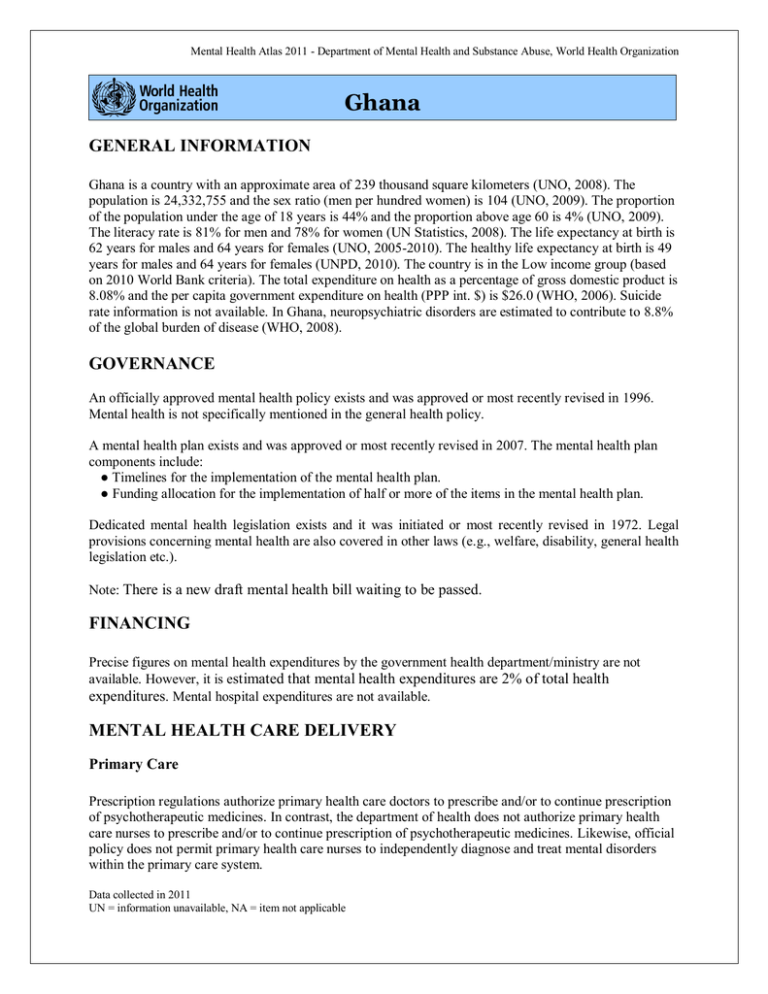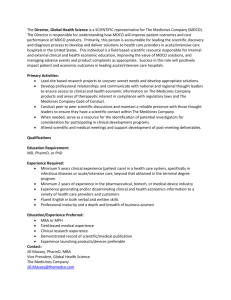Document 11995071
advertisement

Mental Health Atlas 2011 - Department of Mental Health and Substance Abuse, World Health Organization Ghana GENERAL INFORMATION Ghana is a country with an approximate area of 239 thousand square kilometers (UNO, 2008). The population is 24,332,755 and the sex ratio (men per hundred women) is 104 (UNO, 2009). The proportion of the population under the age of 18 years is 44% and the proportion above age 60 is 4% (UNO, 2009). The literacy rate is 81% for men and 78% for women (UN Statistics, 2008). The life expectancy at birth is 62 years for males and 64 years for females (UNO, 2005-2010). The healthy life expectancy at birth is 49 years for males and 64 years for females (UNPD, 2010). The country is in the Low income group (based on 2010 World Bank criteria). The total expenditure on health as a percentage of gross domestic product is 8.08% and the per capita government expenditure on health (PPP int. $) is $26.0 (WHO, 2006). Suicide rate information is not available. In Ghana, neuropsychiatric disorders are estimated to contribute to 8.8% of the global burden of disease (WHO, 2008). GOVERNANCE An officially approved mental health policy exists and was approved or most recently revised in 1996. Mental health is not specifically mentioned in the general health policy. A mental health plan exists and was approved or most recently revised in 2007. The mental health plan components include: ● Timelines for the implementation of the mental health plan. ● Funding allocation for the implementation of half or more of the items in the mental health plan. Dedicated mental health legislation exists and it was initiated or most recently revised in 1972. Legal provisions concerning mental health are also covered in other laws (e.g., welfare, disability, general health legislation etc.). Note: There is a new draft mental health bill waiting to be passed. FINANCING Precise figures on mental health expenditures by the government health department/ministry are not available. However, it is estimated that mental health expenditures are 2% of total health expenditures. Mental hospital expenditures are not available. MENTAL HEALTH CARE DELIVERY Primary Care Prescription regulations authorize primary health care doctors to prescribe and/or to continue prescription of psychotherapeutic medicines. In contrast, the department of health does not authorize primary health care nurses to prescribe and/or to continue prescription of psychotherapeutic medicines. Likewise, official policy does not permit primary health care nurses to independently diagnose and treat mental disorders within the primary care system. Data collected in 2011 UN = information unavailable, NA = item not applicable Mental Health Atlas 2011 - Department of Mental Health and Substance Abuse, World Health Organization The majority of primary health care doctors and nurses have not received official in-service training on mental health within the last five years. Officially approved manuals on the management and treatment of mental disorders are not available in the majority of primary health care clinics. Official referral procedures for referring persons from primary care to secondary/tertiary care exist, as do referral procedures from tertiary/secondary care to primary care. Mental Health Services Availability of mental health facilities Mental health outpatient facilities Day treatment facilities Psychiatric beds in general hospitals Community residential facilities Beds/places in community residential facilities Mental hospitals Beds in mental hospitals Total number Rate per 100,000 Number of of population facilities/beds facilities/beds reserved for children and adolescents only 38 0.16 0 Rate per 100,000 population 3 80 0.01 0.33 0 0 0.0 0.0 2 0.01 0 0.0 0 0.0 0 20 0.0 0.08 24 0.1 0.02 6.16 5 1500 0.0 Access to care Persons treated in mental health outpatient facilities Persons treated in mental health day treatment facilities Admissions to psychiatric beds in general hospitals Persons staying in community residential facilities at the end of the year Admissions to mental hospitals Rates per 100,000 population) Females (%) Under age 18 (%) 123.29 UN UN UN UN UN UN UN UN UN UN UN 24.66 UN UN Long term care in mental hospitals (% of persons staying): Less than 1 year More than 1 and less than 5 years UN UN Data collected in 2011 UN = information unavailable, NA = item not applicable Mental Health Atlas 2011 - Department of Mental Health and Substance Abuse, World Health Organization More than 5 years UN Data collected in 2011 UN = information unavailable, NA = item not applicable Mental Health Atlas 2011 - Department of Mental Health and Substance Abuse, World Health Organization HUMAN RESOURCES Workforce and training Psychiatrists Medical doctors, not specialized in psychiatry Nurses Psychologists Social workers Occupational therapists Other health workers Health professionals working in the mental health sector Rate per 100,000 0.07 0.01 Training of health professions in educational institutions Rate per 100,000 0.01 0.99 2.47 0.04 0.02 0.00 1.64 0.03 0.00 0.00 0.82 NA Informal human resources (Family and User Associations) User Yes 60 Frequently Present in the country? Number of members Participation in the formulation/implementation of policy/plan/legislation? Family Yes 20 Not routinely MEDICINES Expenditures for medicines for mental and behavioral disorders at country level Type of Medicines Expenditures at country level per year and per 100,000 population (in USD) All the psychotherapeutic medicines1 Medicines used for bipolar disorders2 Medicines for psychotic disorders3 Medicines used for general anxiety4 Medicines used for mood disorders 5 1 N03AG01, N05A, N05B, N05C, N06A N03AG01, N05A, N05B, N05C, N06A 3 N05A (excluding N05AN) 4 N05B & N05C 2 Data collected in 2011 UN = information unavailable, NA = item not applicable UN UN UN UN UN Mental Health Atlas 2011 - Department of Mental Health and Substance Abuse, World Health Organization INFORMATION SYSTEMS Persons with mental disorders treated in primary health care Interventions (psychopharmacological and psychosocial) delivered in primary health care for people with mental disorders Persons treated in mental health outpatient facilities Contacts in mental health outpatient facilities Persons treated in mental health day treatment facilities Admissions in general hospitals with psychiatric beds Admissions in mental hospitals Days spent in mental hospitals Admissions in community residential facilities Data on number of people/ activities are collected and reported No Data on age and gender are collected and reported Data on patient's diagnosis are collected and reported No No No No No Yes Yes Yes Yes Yes Yes Yes Yes Yes No No No Yes Yes No Yes Yes No Yes Yes No Note: a specific report focusing mental health activities in the has been published by the Health Department or other responsible government unit in the last three years. 5 N06A Data collected in 2011 UN = information unavailable, NA = item not applicable Mental Health Atlas 2011 - Department of Mental Health and Substance Abuse, World Health Organization UN = information unavailable, NA = item not applicable


